Numerical analysis of human vertebrae using the finite cell method
Setting
Osteoporosis compromises bone strength, increasing the risk of vertebral fractures with severe health consequences. The development of an accurate and reliable patient-specific vertebral model would be of major clinical relevance, for both the prognosis of fractures and the investigation of implant systems. The finite cell method (FCM) is a high-order embedded domain approach which can handle complex geometry without the need for mesh generation [1, 2]. In this work, we apply the FCM to simulate the biomechanical behaviour of human vertebrae. The flexible nature of FCM regarding complex geometry and different types of geometric representation allows us to develop a robust simulation pipeline for patient-specific analysis.
Validation
In the first steps for the validation of the numerical results obtained using FCM, a study was carried out in cooperation with “Klinikum Rechts der Isar”, performing compression tests on fresh-frozen vertebral specimens. FCM models based on micro-CT scans were generated to simulate the mechanical behaviour of the vertebral bodies. Figure 1 depicts a micro-CT-based FCM mesh of a vertebral body. Preliminary results show very good agreement between the numerical results of the FCM models and digital volume correlation (DVC) measurements (see Figures 2 and 3). Next steps will focus on the experimental validation of FCM models based on clinical CT scans, and on multiple-segment models, which incorporate realistic boundary conditions.
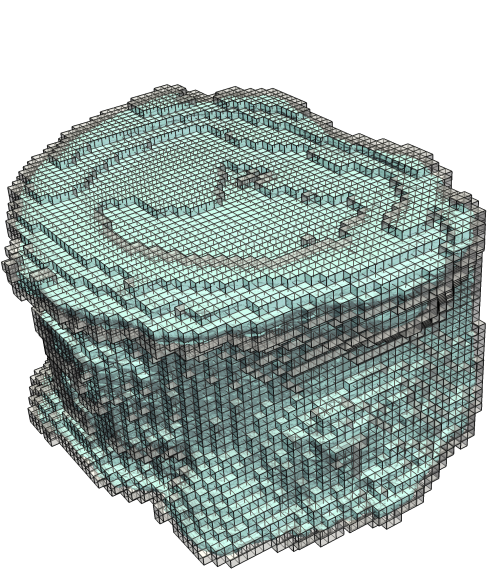 |
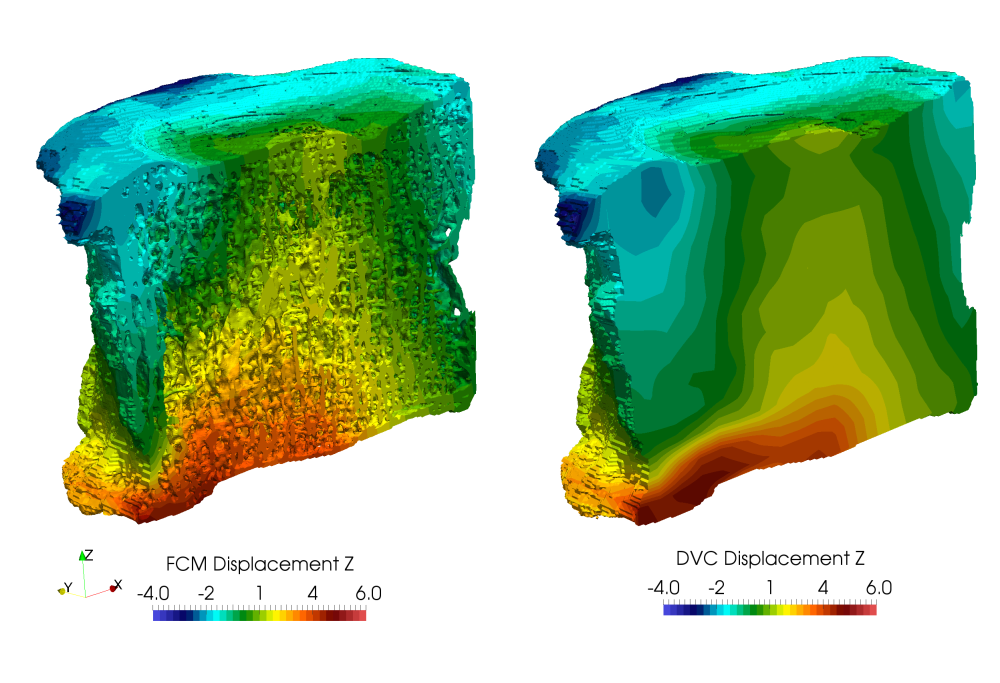 |
|
Figure 1: Micro-CT-based FCM mesh |
Figure 2: Numerical approximation of displacements vs. measurements |
 |
| Figure 3: Linear regression between numerically approximated (FCM) and experimental (DVC) local displacements within a vertebral body. |
Simulation of vertebra-implant system
For the accurate simulation of vertebra-implant systems, the finite cell method is combined with a domain-coupling technique [3]. Using a separate FCM mesh for each subdomain, and weakly enforcing the interface conditions, the discretization can reproduce the weak discontinuity across the material interface. Moreover, the recently developed multi-level hp-refinement scheme [4] is employed to refine the FCM meshes in order to resolve stress concentration and local solution features. This combination of numerical techniques is able to efficiently handle material interface problems involving complex geometries, without the need for boundary-conforming mesh generation.
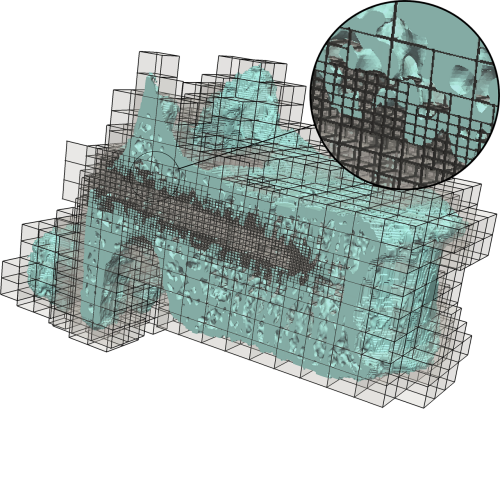 |
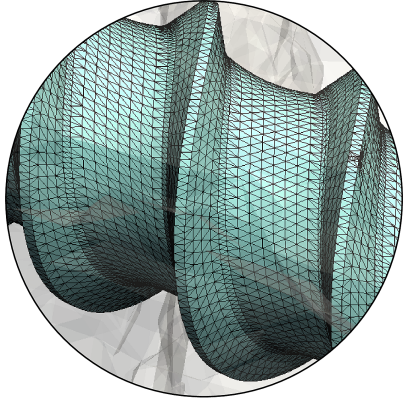 |
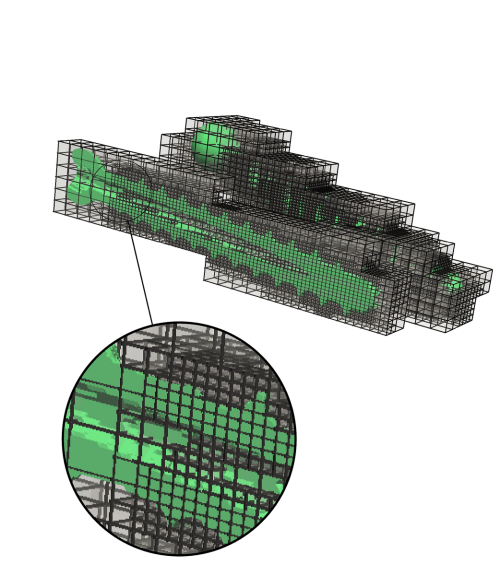 |
| Figure 4: a) Finite cell mesh for the vertebral body | b) surface mesh for coupling interface | c) Finite cell mesh for the screws |
Figure 5 depicts the results of an FCM simulation for a vertebral body with two posterior screws. Using separate FCM meshes for the screws and the vertebral bodies, and applying the multi-level hp-refinement scheme to resolve stress concentrations at the bone-implant interface, the numerical discretization yields mechanically sound results - similar to results reported for simulations using micro-FE models [5]. Further work will consider implants in multiple vertebral bodies (a mobile segment) for more realistic modelling of the boundary conditions.
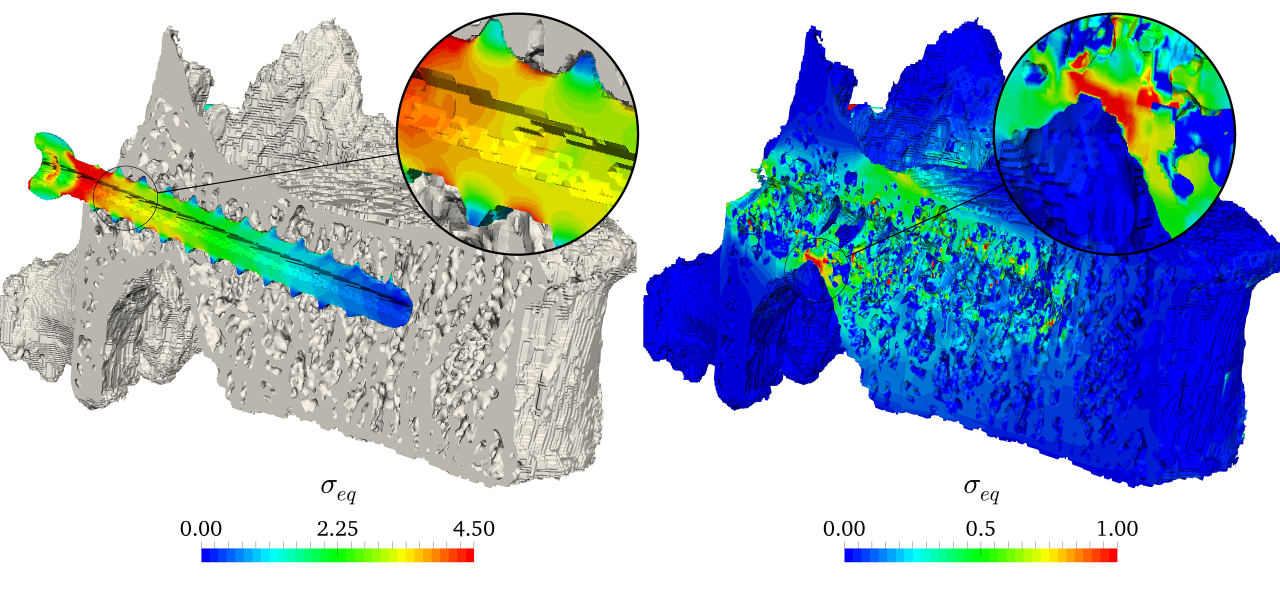 |
| Figure 5: Equivalent Von Mises stresses within the screws and the vertebral body |
References
- Parvizian, J., Düster, A., Rank, E., 2007. Finite cell method. Computational Mechanics
- Ruess, M., Tal, D., Trabelsi, N., Yosibash, Z., Rank, E., 2012. The finite cell method for bone simulations: verification and validation. Biomechanics and modeling in mechanobiology
- Ruess, M., Schillinger, D., Özcan, A.I., Rank, E., 2014. Weak coupling for isogeometric analysis of non-matching and trimmed multi-patch geometries. Computer Methods in Applied Mechanics and Engineering
- Zander, N., Bog, T., Elhaddad, M., Frischmann, F., Kollmannsberger, S., Rank, E., 2016. The multi-level hp-method for three-dimensional problems: Dynamically changing high-order mesh refinement with arbitrary hanging nodes. Computer Methods in Applied Mechanics and Engineering
- Ruffoni, D., Wirth, A.J., Steiner, J.A., Parkinson, I.H., Müller, R., van Lenthe, G.H., 2012. The different contributions of cortical and trabecular bone to implant anchorage in a human vertebra. Bone
Publications
-
Multi-level hp-finite cell method for embedded interface problems with application in biomechanics
International Journal for Numerical Methods in Biomedical Engineering 34 (4), pp. e2951, Wiley, 2017
DOI: 10.1002/cnm.2951 - Status: Verlagsversion / published
-
Micro-CT based finite cell analysis of vertebral bodies
In: Engineering Mechanics Institute Conference 2017, San Diego, CA, USA, 2017
-
Adaptive discretizations for bone-implant systems using the finite cell method
In: Engineering Mechanics Institute Conference 2016, Nashville, TN, USA, 2016
-
Loading simulation of spinal vertebrae using the finite cell method
In: VI International Conference on Computational Bioengineering, Barcelona, Spain, 2015
-
Coupling scales and adaptive refinement for simulation of bone-fixation interfaces using the Finite Cell Method
In: VI International Conference on Coupled Problems in Science and Engineering, Venice, Italy, 2015